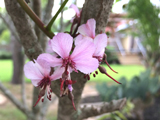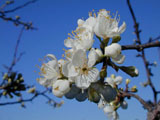Understory trees like Mexican buckeye and Mexican plum provide a multitude of benefits such as color, layering and buffering from pesky neighbors. And they’re both featured in our fall WaterSaver Landscape Coupon.
Understory trees add color, vertical structure and wildlife benefits. No home landscape should be without them.
Also referred to as ornamental trees, understory trees remain petite beneath large shade trees and provide layers within the urban forests that assist with rain storage and sunlight dispersion. Often they provide colorful flowers mostly in the spring, but occasionally in the summer. Wildlife — from the two- to eight-legged variety — use understory trees as food and shelter. And most bird nests are found in these trees.
Several understory trees are featured in our fall WaterSaver Landscape Coupon. Two versatile and tough selections are the Mexican buckeye and Mexican plum. Both are adaptable to all soils of the area, but both prefer partially shaded areas.
Mexican buckeye
Features
 Not a true buckeye, Mexican buckeye produces a three-lobed shell that contains three dark brown seeds with a small white “eye” resembling a deer’s eye. Mexican buckeye has light pink flowers, which are some of the first of the year arriving in late February and early March. The leaves are compound with five to seven leaflets. Average height about 12 feet.
Not a true buckeye, Mexican buckeye produces a three-lobed shell that contains three dark brown seeds with a small white “eye” resembling a deer’s eye. Mexican buckeye has light pink flowers, which are some of the first of the year arriving in late February and early March. The leaves are compound with five to seven leaflets. Average height about 12 feet.
Where to plant
It may be planted in full sun, but prefers partial shade. Slope or flat ground doesn’t matter.
When to plant
As with all woody trees and shrubs, Nov. 1 to April 1 is planting time.
Water
After an initial establishment period, Mexican buckeye requires water 4-6 times a year a most. It is a native, after all.
Fertilizer
None needed except for annual compost and mulch.
Pests
Humans with weed-eaters and mowers seem to be the greatest pest. Deer don’t like the taste of its leaves.
Mexican plum
Features

Mexican plum produces fragrant white flowers in early March. The fruit is smallish, but very tasty to wildlife and humans alike when it ripens late July to early September. The leaves are distinctive with thick, netted veins. Average height about 20 feet.
Where to plant
Mexican plum does not like full sun at all, but will tolerate it with late afternoon shade so don’t plant it in the front along the street. It does tolerate sands and heavy clays, but really prefers well drained, moist soils.
When to plant
Nov. 1 to April 1.
Water
After establishment, water once a month March through October if no effective rain has occurred. One to 1 ½ inches is sufficient.
Fertilizer
None needed except for annual compost and mulch.
Pests
Fondly called the “long legged hog,” whitetail deer love the Mexican plum. The plum should not be planted without some sort of protection. Humans with weed-eaters are also frequent pests.
Understory trees like Mexican buckeye and Mexican plum provide a multitude of benefits such as color, layering, food, shelter and buffering from pesky neighbors. No home landscape should be without them. Make sure your yard isn’t missing these important features.




